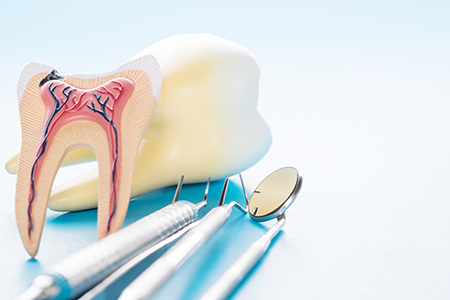Call Us Today!
(248) 863-9109
New Patients
(248) 221-2314

If your dentist has recommended root canal therapy, try not to panic. Modern root canal treatment is a predictable, well‑established procedure that relieves pain, removes infection, and preserves natural teeth far more often than extraction. For many people, a root canal is the best way to restore comfort and function while keeping their smile intact.
At the office of Royal Dental Center, we combine careful diagnosis, up‑to‑date instrumentation, and patient-centered care to make the process efficient and as comfortable as possible. Our team prioritizes communication: we explain each step, answer your questions, and tailor treatment to your needs so you know what to expect from the first visit through recovery.
A tooth preserved with root canal therapy often functions like any other natural tooth for many years. Keeping a natural tooth maintains proper chewing efficiency, helps preserve surrounding bone, and supports adjacent teeth so they don’t drift or wear unevenly. In short, saving a tooth usually preserves oral health and avoids more complex restorative work later on.
Success rates for contemporary root canal treatment are high when procedures are performed with careful technique and followed by appropriate restoration. Advances in imaging, magnification, and filling materials mean clinicians can clean and seal root systems more effectively than ever, which contributes to durable outcomes for patients.
Choosing to treat an infected or injured tooth can also limit the spread of infection into surrounding tissues. Leaving a severely compromised tooth untreated increases the risk of persistent pain, bone loss, and in some cases, systemic complications. Timely root canal therapy is often the most conservative and health-focused option.

Each tooth contains a soft core called the dental pulp, made up of nerves, blood vessels, and connective tissue. That tissue helps the tooth develop and provides sensory feedback, but once a tooth is fully formed it can survive without an active pulp. When the pulp becomes irreversibly inflamed or infected — from deep decay, trauma, or extensive restoration — root canal therapy becomes the means to remove the diseased tissue and protect the tooth.
Pain and sensitivity are common signals that the pulp is compromised, but not every problem causes obvious symptoms. Sometimes issues are discovered on routine X-rays or during a clinical exam before you notice discomfort. A careful evaluation helps determine whether a root canal, monitoring, or another form of treatment is most appropriate.
Pay attention to warning signs and seek prompt assessment if you notice persistent problems. Early intervention improves the likelihood of saving the tooth and reduces the chance that more invasive treatment will be necessary later.
Common indicators that a tooth may need root canal therapy include:
Pain that persists, worsens at night, or interferes with sleep often signals serious irritation or infection of the tooth’s inner tissues.
Brief sensitivity is common; prolonged or intense pain after temperature exposure can indicate deeper pulp involvement.
Pain with pressure suggests the nerve or surrounding tissues are irritated — a sign that evaluation and likely treatment are needed.
A tooth that turns darker after an injury or over time may have damaged internal tissue and should be examined.
Damage that exposes inner structures makes the tooth vulnerable to infection and often leads to pulp inflammation.
Localized swelling or drainage can indicate an abscessed tooth; this represents an active infection that requires treatment.
Infection and bone loss around a tooth may produce movement; addressing the underlying cause can often restore stability.

Delay can make a treatable situation more complicated. An infection that is contained today may spread deeper into the root or surrounding bone if left untreated, sometimes necessitating additional procedures or even extraction. Early diagnosis and intervention often mean simpler, more predictable care.
In some cases a tooth with pulp disease does not cause dramatic symptoms but shows changes on X‑rays — a reason routine exams and imaging are valuable. Detecting pathology early allows for prompt planning and increases the chances that the tooth can be restored for long‑term function.
When a root canal is recommended, discussing timing with your dental team helps you make an informed choice. Coordinating the endodontic treatment with the final restoration — often a crown — ensures the tooth is protected and reinforced as soon as possible.
Root canal therapy is a focused, stepwise procedure designed to remove infected tissue and seal the internal spaces of the tooth. Treatment typically begins with a careful exam and imaging, followed by local anesthesia to provide a comfortable experience. If you have dental anxiety, dental sedation options can be discussed to help you relax.
Once comfortable, the dentist creates a small access opening to reach the canals, then removes the diseased pulp. The canals are cleaned, shaped, and disinfected using sterile instruments and irrigation solutions. These steps are important to eliminate bacteria and prepare the canals for a durable seal.
Canal filling material — a biocompatible substance designed for long‑term stability — is placed to prevent recontamination. Depending on the tooth’s complexity and presence of infection, treatment may be completed in a single appointment or over two visits to ensure thorough cleaning and healing.

At the office of Royal Dental Center, we emphasize attentive follow‑up and practical guidance so healing progresses smoothly. Although the root canal removes the source of pain, some mild soreness is common as the surrounding tissues recover. This typically improves within a few days and can be managed with recommended analgesics and sensible measures.
Be mindful of the treated tooth during the healing period. Until a permanent crown or other definitive restoration is placed, the tooth is more susceptible to fracture — avoiding hard or sticky foods and chewing on the opposite side helps reduce that risk. Completing the recommended restoration is essential for long‑term durability.
Keep up with routine oral hygiene and attend scheduled checks so your clinician can monitor healing. If you notice persistent swelling, increasing pain, or changes in bite or appearance after treatment, contact your dental team promptly for evaluation.
Numbness from local anesthesia can last a few hours. Take care to avoid biting soft tissues while sensation returns.
A period of slight discomfort is normal; it usually subsides in days. Your dentist will advise on pain control if needed.
When an infection is present, antibiotics may be prescribed. If given, complete the course as directed.
A definitive crown or restoration restores strength and prevents future complications — scheduling this step in a timely way is important.
Brushing, flossing, and regular dental visits remain essential to support healing and long‑term oral health.
With skilled treatment and appropriate follow‑up, a tooth that has had root canal therapy can serve you for many years or a lifetime. If you have questions about symptoms, treatment options, or the best plan for restoring a damaged or infected tooth, please contact us for more information and to schedule an evaluation.
A root canal procedure is the best way to save a tooth that has been damaged by decay or injury and preserve your natural smile. The alternative is an extraction and treatment to replace the tooth. While at times a tooth is non-restorable and an extraction is the only option, when possible, it’s best to try and save your natural tooth. With proper care, a tooth with root canal therapy can serve your smile well for many years to come.
Despite lingering myths from before the age of modern dental anesthesia and technology, having a root canal procedure today is as routine and comfortable as visiting the dentist for a filling. While the procedure is performed under local anesthesia with your tooth completely numbed, we can also discuss options in dental sedation.
Whether the symptoms of a dental infection subside after a course of antibiotics, a draining abscess provides you with some temporary pain relief, or a tooth with radiographic evidence of pathology has not yet developed symptoms, it’s essential, before an infection worsens or occurs, to have a root canal procedure performed. In this way, the tooth can be disinfected, filled, and sealed to protect your health and avoid further problems.
If you have sustained a dental injury, have a toothache, jaw pain, swelling, or are experiencing any other unusual and uncomfortable oral symptoms, contact our office immediately for care. Dental problems that have not been evaluated and treated can significantly worsen, producing more severe damage and consequences for the involved teeth, your oral health, and even your overall wellbeing. Once you get in touch with our office, our friendly and compassionate office team will get you in for care at your earliest convenience.
While some root canal procedures can be completed in one visit, others may involve 2 or 3 appointments. How long it takes depends on various factors, including active infection, the number of canals in the tooth, and the tooth’s location or anatomy.
With a success rate that exceeds 95%, root canal therapy remains the most effective procedure to save a tooth in which the inner vital tissues have been damaged. However, as with all healthcare procedures, there are a small percentage of cases where the teeth become symptomatic a second time. The good news is that many of these teeth can still be saved with root canal retreatment or a minor surgical procedure known as an apicoectomy.
The best ways to maintain a tooth with root canal therapy are to get the proper restoration required to rebuild and protect the tooth, maintain proper oral hygiene, and schedule appointments for routine dental checkups and care.
Saving a tooth with root canal therapy is a wise investment that, in the long run, is typically less costly and invasive than having the tooth extracted and replaced with a fixed bridge or implant. As far as the exact cost of care, it can vary depending on which tooth is being treated. Many dental insurance plans provide coverage for root canal therapy. At the office of Royal Dental Center, we do our best to optimize your dental benefits and minimize your out-of-pocket expenses. Our staff will answer all your questions about the cost of care and discuss all your payment options.
At the office of Royal Dental Center, we use the latest technology and most effective methods of care to provide precise and gentle care. Our reputation for excellence is based upon a consistent record of achieving successful treatment outcomes while providing prompt, stress-free, and convenient treatment for every type of dental need.
A root canal is a dental procedure that removes diseased or damaged pulp from inside a tooth, cleans and disinfects the internal canals, and seals the space to prevent reinfection. The goal is to eliminate pain and infection while preserving the natural tooth structure and biting function. By treating the inner tissues rather than extracting the tooth, root canal therapy helps maintain proper chewing, alignment, and jawbone support.
Modern root canal techniques use advanced instruments and irrigation solutions to improve precision and outcomes. Most treated teeth remain functional for many years when properly restored and maintained. Root canal therapy is widely accepted as the preferred method to save a compromised tooth whenever feasible.
Common signs that may indicate the need for root canal therapy include persistent tooth pain, heightened sensitivity to hot or cold, discomfort when biting or touching the tooth, gum swelling, and visible discoloration of the affected tooth. Some patients describe pain that wakes them at night or a lingering ache after exposure to hot or cold stimuli. A loose or mobile tooth and drainage of an abscess are also warning signs that require prompt evaluation.
Not every tooth that needs treatment shows clear symptoms; some problems are first detected during a routine exam or on dental X-rays as periapical changes or deep decay near the pulp. Because presentations vary, a thorough clinical exam and radiographs are essential to determine whether root canal therapy is appropriate. Early assessment reduces the risk of more extensive infection and complications.
Thanks to modern anesthesia and techniques, most patients report little to no pain during a root canal procedure, and many describe it as comparable to having a filling placed. Local anesthesia numbs the area effectively, and additional sedation options are available for patients with dental anxiety. The dentist takes steps to ensure comfort throughout the appointment and monitors sensations to adjust care as needed.
It is common to experience some mild to moderate soreness or tenderness around the treated tooth for a few days after the procedure as the surrounding tissues heal. Over-the-counter pain relievers are often sufficient to manage post-operative discomfort, and the practice will provide clear instructions for care. If severe pain, swelling, or persistent symptoms occur, contact the dental office promptly for evaluation.
During the procedure the dentist first administers local anesthesia and isolates the tooth with a rubber dam to keep the area clean and dry. The tooth is opened to access the pulp chamber, infected or damaged tissue is removed, and the root canals are cleaned, shaped, and disinfected using specialized instruments and irrigating solutions. Once the canals are prepared, they are filled with a biocompatible material and sealed to prevent bacteria from reentering the space.
Some cases are completed in a single visit while others require multiple appointments depending on canal anatomy, the presence of infection, or the need for interim medication. A temporary filling is often placed until a final restoration can be completed. After the root canal is finished, a permanent restoration such as a crown is typically recommended to restore strength and function to the tooth.
Treatment time varies by tooth type, anatomy, and whether an active infection is present; simple cases may be completed in a single visit while complex molars with multiple canals or active infections can require two or three appointments. A typical appointment for a straightforward case commonly lasts between an hour and 90 minutes, though this can vary depending on the specific situation and the need for additional procedures. Your dentist will explain the expected timeline during your consultation so you know what to expect.
When multiple visits are necessary, the clinician may place a medicated dressing between appointments to control infection and encourage healing. Follow-up care includes scheduling the permanent restoration to protect the treated tooth and monitoring healing on clinical exam and radiographs. Keeping scheduled appointments helps ensure an efficient recovery and long-term success.
Root canal therapy is generally safe and effective, but like any dental procedure it carries some risks and potential complications, such as persistent infection, incomplete cleaning of complex canal anatomy, fracture of instruments inside a canal, or an adverse reaction to materials. In a small number of cases symptoms may persist or recur, necessitating retreatment or apical surgery to address infection at the root tip. The likelihood of complications is reduced with timely treatment, careful technique, and appropriate restoration following therapy.
Patients can help minimize risk by maintaining excellent oral hygiene, treating new decay promptly, and following post-treatment instructions provided by the dental team. Regular dental exams and X-rays allow early detection of problems that could threaten the treated tooth. When complications arise, the dentist will review all options and recommend the most conservative, evidence-based approach to preserve oral health.
Many teeth that receive root canal therapy benefit from a crown or other full-coverage restoration, particularly posterior teeth that endure heavy chewing forces and are at greater risk of fracture. A crown protects the remaining tooth structure, restores proper function, and helps prevent reinfection by sealing margins against bacterial ingress. Your dentist will evaluate the amount of remaining tooth structure and the location of the tooth to determine the most appropriate restoration.
In some cases, front teeth with limited structural loss can be restored with a bonded composite filling rather than a crown, but this decision depends on functional demands and esthetic considerations. Regardless of the restorative choice, placing the permanent restoration in a timely manner is important to maximize the longevity of the treated tooth. Discuss restoration options and timing with your dentist to arrive at a plan that meets your needs.
Immediately after treatment, protect the treated tooth by avoiding chewing on that side until the numbness wears off and any temporary filling is replaced with a permanent restoration. Take any prescribed medications and follow the aftercare guidance provided by your dental team to manage discomfort and prevent infection. Continue to brush and floss daily, taking care around the treated tooth while healing occurs.
Long-term care includes restoring the tooth with the recommended permanent restoration and maintaining regular dental exams and cleanings to monitor the tooth and surrounding tissues. If you notice increasing pain, swelling, drainage, or a new sensitivity, contact Royal Dental Center in West Bloomfield, MI for prompt evaluation and treatment. Early attention to post-treatment concerns helps protect your oral health and the longevity of the restored tooth.
Yes, retreatment is often a viable option when symptoms recur or if persistent infection is detected after the initial root canal. Causes for failure include missed canals, new decay that compromises the seal, fractures that allow bacterial contamination, or complex anatomy that was not fully cleaned initially. Retreatment involves reopening the tooth, removing the previous filling material, re-cleaning and disinfecting the canals, and then sealing them again to resolve infection.
In some situations, where retreatment is not feasible or has a low chance of success, apical surgery (an apicoectomy) or extraction and replacement may be considered as alternatives. Advanced imaging and careful clinical assessment guide the decision-making process and inform a tailored treatment plan. The office of Royal Dental Center can evaluate recurrent symptoms, discuss appropriate options, and outline a recommended course of care based on individual circumstances.
With proper restoration and good oral hygiene, a tooth that has undergone root canal therapy can last many years and often a lifetime. Factors that influence longevity include the quality of the root canal filling and permanent restoration, the amount of remaining tooth structure, the presence of new decay or gum disease, and habits such as clenching or chewing hard objects. Regular dental checkups and timely attention to new problems help preserve the treated tooth.
Maintaining daily brushing and flossing, using protective appliances when recommended, and following your dentist's guidance for restorations and follow-up care all contribute to long-term success. If you notice changes such as pain, swelling, or a broken restoration, schedule an evaluation promptly so the team can intervene before more extensive problems develop. Early intervention often simplifies treatment and improves outcomes for treated teeth.
Take the first step toward exceptional dental care! Schedule your appointment with Royal Dental Center today and experience personalized treatment, advanced technology, and a caring team dedicated to your comfort and oral health. Don’t wait—your best smile starts now.
